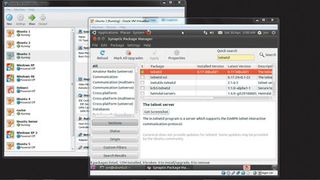In the sand

One solution is to use a 'sandbox' to quarantine running code so that any attempt to make unauthorised changes to the system can be prevented caught before they are carried out. Some antivirus software (even free versions) now provides the facility to automatically run suspect or unsigned programs in a sandbox.
Perhaps more importantly, web browsers are also beginning to use sandboxes, which is another good reason to abandon that old version of Internet Explorer. The ability of malicious or hijacked sites to silently install code on your computer simply by surfing to them will be greatly reduced.
A sandbox operates a little like a virtual machine, in that it provides the running code with a virtual environment containing everything it needs to believe it's running on real hardware. However, it actually runs in a carefully crafted simulation with severe limits placed on it. Any changes to the actual operating system are never allowed to propagate beyond the sandbox.
The sandbox used in Google's Chrome browser is a good example of the concept in action. Rather than write a complete virtualisation product, the developers used Windows' own security model to help Chrome achieve its renowned speed.
Chrome's sandbox works because malware needs to write to unauthorised parts of RAM or to the hard disk to install itself so that it can run again after a reboot. In Windows, this can only be done using a system call to the kernel's I/O functions, all of which check the privileges of the process calling them. Chrome's sandbox is set up so that write operations never have the correct privileges and therefore fail. Return codes are faked, so the malware believes it's installing itself, but never does.
For developers, Chrome's sandbox is particularly useful because it isn't deeply embedded in the browser. Developers can use it to test their own programs and make sure that they don't try to do anything they shouldn't, or which could be construed as malicious.
Chrome tarnished
Chrome's sandbox is among the most secure. In the first three years since the browser's release, it resisted all attempts at subversion during the prestigious Pwn2Own hacking competition. Held during the annual CanSecWest security conference, the competition has seen IE8 and Firefox hacked wide open. However, Chrome's sandbox may have been breached, if the claims of one French security company are true.
Get daily insight, inspiration and deals in your inbox
Sign up for breaking news, reviews, opinion, top tech deals, and more.
Researchers at VUPEN Security recently issued a security advisory giving details of what it claims is a simple, two-step process for breaking out of Chrome's sandbox and making unauthorised changes to the operating system. The news of Chrome's 'pwning' via its sandbox has been met with concern in the online security community, not least because VUPEN Security has chosen not to share its findings with Google, which would be more usual.
When a security researcher finds an exploitable bug, he or she usually contacts the developer with the details and perhaps a suggested fix. Only when the developer has implemented a fix and issued new code does the researcher exercise their bragging rights by publishing full details of the bug online.
However, in a statement, VUPEN Security says that, "We did not alert Google as we only share our vulnerability research with our Government customers for defensive and offensive security". This stance hints at the commercialisation of so-called 'zero day' exploits – those not reported to the developer so that they can be fixed but instead kept for private exploitation or sale.
At a time when governments are talking openly about their preparations for cyber warfare, exploitable bugs, packaged and ready to use with exploit code, can command serious money. However, several pundits have questioned VUPEN Security's announcement. If, they ask, VUPEN is planning to sell its Chrome exploit to a government customer to use as a weapon, why publicise it and put potential adversaries on their guard?
Take the blue pill

We take the idea of virtualisation for granted as a cheap or free path to creating networks on a single physical computer, but it is far from being a software-only technique. Since the mid 2000s, Intel and AMD have included hardware virtualisation inside their chips.
Both companies aimed to make the creation of virtual machine software easier, but their technologies had an unexpected side effect. When you create and run a virtual computer in a package like Oracle's free VirtualBox, for example, the entire simulation runs under the control of a process known as a hypervisor.
The hypervisor (which is also referred to as a virtual machine manager) makes sure that the entire physical computer is apparently available to the virtual machine. It handles access to everything from the BIOS to the USB ports, and resolves any resource access conflicts with other virtual machines it may be controlling at the same time.
However, not long after AMD and Intel released chips supporting virtualisation, Polish security guru Joanna Rutkowska created an ingenious hacking technique that ensures that people can see anything the chips are doing, including everything you type in.
For this, Rutkowska created a simple hypervisor that tells the processor to run under its control. However, the chip itself and the operating system that's running on it have no way of knowing that it has been flipped into this malicious hypervisor. They simply continue running as if nothing had happened.
Rutkowska called her approach the Blue Pill after the concept of the same name in cult sci-fi movie The Matrix. Running the Blue Pill exploit puts the chip into a simulation of the computer, which is indistinguishable from the real thing. Once inside this simulation, everything the running operating system does is laid bare.
Because the simulation is indistinguishable from the real thing, malware using the same concept (like a rootkit, for example) can be created that, potentially, cannot be detected. Other researchers have pointed out flaws in Rutkowska's approach, but there's no doubting that the sheer convenience of virtualisation may ultimately prove the downfall of current processor protection measures, and lead to ever more ingenious defence mechanisms.
-------------------------------------------------------------------------------------------------------
First published in PC Plus Issue 313. Read PC Plus on PC, Mac and iPad
Liked this? Then check out Best antivirus 2011: 10 programs on test
Sign up for TechRadar's free Week in Tech newsletter
Get the best tech stories of the week, plus the most popular news and reviews delivered straight to your inbox. Sign up at http://www.techradar.com/register
Follow us on Twitter * Find us on Facebook * Add us on Google+












